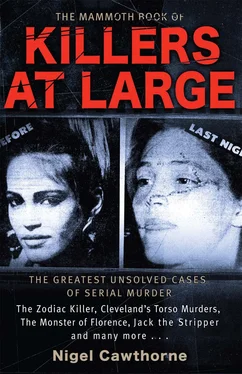However, there was one inconvenient fact that spoiled this picture. Dion’s white Boston Red Sox baseball cap was found neatly hanging from a post on the riverbank near to the spot the police assumed he fell in. Did he take it off and hang it there before he plunged into the water? Police Chief Kondracki said that a group of joggers passing by had seen it on the ground and one of them had picked it up and put it there. However, the joggers say that the cap was already on the post and they did not touch it.
The fact that five muscular young men had all died in the same way was, the police maintained, a coincidence. La Crosse was a college town with a culture of heavy drinking. And when young men are drunk, accidents happen. But long-time residents wondered why it had never happened before. Others asked why other riverside college towns, such as Winona, Minnesota—25 miles upstream—did not suffer from a similar string of drownings. The idea that a serial killer was at work began to circulate again.
Everyone had their own theory. Perhaps La Crosse had its own cold-weather version of Aileen Wuornos, the prostitute in Florida who took her revenge on men by killing her clients. Maybe the killer was a taxi driver who offered his drunken victims a ride home, or a homicidal cop was prowling the streets at night.
Talk of a serial killer on the loose became so pervasive that Kondracki took the unprecedented step of calling a town meeting which was broadcast live on local TV. One of those fielding the questions was Police Lieutenant Dan Marcou, who was also the uncle of one of the five boys who died in the river and “fought back tears as he chastised the crowd,” a reporter said.
“The La Crosse Police Department investigated all of these [deaths] thoroughly,” Marcou insisted. “I have to listen to people applaud at the thought that my nephew was killed by a serial killer. This community is like an alcoholic. It would rather think that a killer is on the loose than admit that it’s got a drinking problem.”
However critics pointed out that the police had dismissed the idea that a killer or killers were responsible for some or all of the deaths too readily and had failed to investigate any of the deaths as possible homicides.
The University of Wisconsin was also eager to crush the idea that a serial killer was at work in their seat. The chair of the psychology department Betsy Morgan, who has taught at the university for ten years, did not buy it. She and the criminal-justice professor Kim Vogt wrote an open letter to students called “Why We Are 99.9 Percent Sure It Is Not A Serial Killer”, pointing out that students and the local brewing industry would rather believe that a serial killer was at large than examine their own penchant for excessive drinking. It concluded with a homily on Occcam’s razor: “When you hear hooves behind you, you should expect to see horses, not zebras… In the case of Jared Dion and other students who have drowned in the past several years, the ‘horse’ diagnosis is ‘alcohol’ while the ‘zebra’ plays the part of the ‘serial killer.’ It was a plain old tragic accident that took the life of [Jared Dion] and the others who drowned.”
Vogt also dismissed it fact that all the victims shared specific physical characteristics. While it is true that serial killers are often drawn to victims who were similar in looks and age and occupation, the population of northern Midwest is unusually homogeneous. College towns attract a disproportionate number of young men who go out at night and get drunk.
“The coincidence that people always pull up is that they’re all college-age, they all have brown hair and they’re all white,” Vogt said. “Well, that describes 95 percent of our population… a serial killer would have to really hunt to find a young man who didn’t match the profile of the victims.”
She also pointed out that, statistically, young men are ten times more likely than young women to die by drowning.
Vogt searched the records and found no incidence of a serial killer who drowned their victims. True, there were killers who intentionally drowned their victims. In rare cases they had used drowning as a method in multiple murders—for example, Andrea Yates, the psychotic Texas mother who drowned her five young children one by one in the bathtub in 2001. But serial killers, who plan their attacks and get a kick from the execution, were different.
“Serial killers,” she said, “want to see people die.”
As psychotherapist and profiler John Kelly dismissed the idea that a serial killer was responsible for the La Crosse drownings was “pretty weird”.
“They could have been murdered, but the person was just so good at doing it that they didn’t leave any physical evidence,” he told Stuff magazine. “If a serial killer is involved, they’re going to make sure that person is dead before they throw them in the river. They’re not going to take any chances that they could be identified in court. I suppose the killer could sedate the victim and drown him in a tub or something like that and then throw him in the river.”
Such a scenario seems unlikely. But some experts are not so sure. Reviewing the cases for Stuff magazine, criminal psychologist Dr Maurice Godwin said: “The probability is virtually zero that five intoxicated students just happened to walk similar or even different routes and end up on the river bank.”
Indeed, even to get to the bank, a drunken student would have to make his way down a concrete stairway and across several feet of loose rocks.
Pat Brown, an expert on sexually motivated homicide, concurs.
“More people are killed by serial killers than we realize,” she says.
True, it is not easy to lure a victim to a convenient body of water.
“So you have to bring somebody back and try to get them into your bathtub which is not the easiest thing in the world,” she says. “Unless you’re Jeffrey Dahmer.”
But then there are people who fantasize about becoming the next Jeffrey Dahmer and get sexually aroused by the act of drowning. She even has a candidate, though his name has been withheld as the man has never been charged with related offences, nor has been named as a formal suspect in the case. She says she first came across the man when she was investigating a similar case.
In 2002, 21-year-old University of Minnesota student Chris Jenkins drowned 120 miles upstream in Minneapolis after being kicked out of a Halloween fancy-dress party at the Lone Tree Bar & Grill at 528 Hennepin Avenue minutes before midnight on 31 October.
Although his car was parked just south of the Warehouse District bar, he was last seen walking north, clad in an American Indian costume. Chuck Loesch, a private detective hired by the family, believed that Jenkins intended to walk to his apartment near Dinkytown, which would involve crossing the Mississippi River.
A senior in the business school, his disappearance sparked a communitywide search. Numerous University of Minnesota students and hundreds of other volunteers scoured the area but found nothing. Then, in late February 2003, Jenkins’ body was pulled from the Mississippi River near the St Anthony Falls in downtown Minneapolis.
The medical examiner spent seven hours on the post mortem, but did not find any obvious indication of foul play. Nor was there any reason to believe that he had died from natural causes. So the exact manner of Chris’s death had been listed officially as “undetermined”. However, while the blood-alcohol level in his heart was only 0.12 percent, tests found a high level of the date-rape drug known as GHB in his system—though medical examiners maintain the body could produce this substance naturally.
At that time, the coroner did not classify the death as a crime. However, others were not so sure. One clue that it was a homicide was that Jenkins was outside without his coat, wallet or cell phone.
Читать дальше











